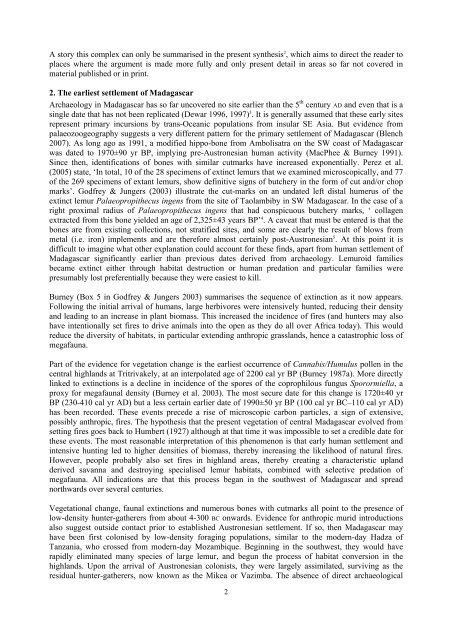Paper for Cambridge 2007 proceedings submit.pdf - Roger Blench
Paper for Cambridge 2007 proceedings submit.pdf - Roger Blench
Paper for Cambridge 2007 proceedings submit.pdf - Roger Blench
Create successful ePaper yourself
Turn your PDF publications into a flip-book with our unique Google optimized e-Paper software.
A story this complex can only be summarised in the present synthesis 2 , which aims to direct the reader to<br />
places where the argument is made more fully and only present detail in areas so far not covered in<br />
material published or in print.<br />
2. The earliest settlement of Madagascar<br />
Archaeology in Madagascar has so far uncovered no site earlier than the 5 th century AD and even that is a<br />
single date that has not been replicated (Dewar 1996, 1997) 3 . It is generally assumed that these early sites<br />
represent primary incursions by trans-Oceanic populations from insular SE Asia. But evidence from<br />
palaeozoogeography suggests a very different pattern <strong>for</strong> the primary settlement of Madagascar (<strong>Blench</strong><br />
<strong>2007</strong>). As long ago as 1991, a modified hippo-bone from Ambolisatra on the SW coast of Madagascar<br />
was dated to 1970±90 yr BP, implying pre-Austronesian human activity (MacPhee & Burney 1991).<br />
Since then, identifications of bones with similar cutmarks have increased exponentially. Perez et al.<br />
(2005) state, ‘In total, 10 of the 28 specimens of extinct lemurs that we examined microscopically, and 77<br />
of the 269 specimens of extant lemurs, show definitive signs of butchery in the <strong>for</strong>m of cut and/or chop<br />
marks’. Godfrey & Jungers (2003) illustrate the cut-marks on an undated left distal humerus of the<br />
extinct lemur Palaeopropithecus ingens from the site of Taolambiby in SW Madagascar. In the case of a<br />
right proximal radius of Palaeopropithecus ingens that had conspicuous butchery marks, ‘ collagen<br />
extracted from this bone yielded an age of 2,325±43 years BP’ 4 . A caveat that must be entered is that the<br />
bones are from existing collections, not stratified sites, and some are clearly the result of blows from<br />
metal (i.e. iron) implements and are there<strong>for</strong>e almost certainly post-Austronesian 5 . At this point it is<br />
difficult to imagine what other explanation could account <strong>for</strong> these finds, apart from human settlement of<br />
Madagascar significantly earlier than previous dates derived from archaeology. Lemuroid families<br />
became extinct either through habitat destruction or human predation and particular families were<br />
presumably lost preferentially because they were easiest to kill.<br />
Burney (Box 5 in Godfrey & Jungers 2003) summarises the sequence of extinction as it now appears.<br />
Following the initial arrival of humans, large herbivores were intensively hunted, reducing their density<br />
and leading to an increase in plant biomass. This increased the incidence of fires (and hunters may also<br />
have intentionally set fires to drive animals into the open as they do all over Africa today). This would<br />
reduce the diversity of habitats, in particular extending anthropic grasslands, hence a catastrophic loss of<br />
megafauna.<br />
Part of the evidence <strong>for</strong> vegetation change is the earliest occurrence of Cannabis/Humulus pollen in the<br />
central highlands at Tritrivakely, at an interpolated age of 2200 cal yr BP (Burney 1987a). More directly<br />
linked to extinctions is a decline in incidence of the spores of the coprophilous fungus Sporormiella, a<br />
proxy <strong>for</strong> megafaunal density (Burney et al. 2003). The most secure date <strong>for</strong> this change is 1720±40 yr<br />
BP (230-410 cal yr AD) but a less certain earlier date of 1990±50 yr BP (100 cal yr BC–110 cal yr AD)<br />
has been recorded. These events precede a rise of microscopic carbon particles, a sign of extensive,<br />
possibly anthropic, fires. The hypothesis that the present vegetation of central Madagascar evolved from<br />
setting fires goes back to Humbert (1927) although at that time it was impossible to set a credible date <strong>for</strong><br />
these events. The most reasonable interpretation of this phenomenon is that early human settlement and<br />
intensive hunting led to higher densities of biomass, thereby increasing the likelihood of natural fires.<br />
However, people probably also set fires in highland areas, thereby creating a characteristic upland<br />
derived savanna and destroying specialised lemur habitats, combined with selective predation of<br />
megafauna. All indications are that this process began in the southwest of Madagascar and spread<br />
northwards over several centuries.<br />
Vegetational change, faunal extinctions and numerous bones with cutmarks all point to the presence of<br />
low-density hunter-gatherers from about 4-300 BC onwards. Evidence <strong>for</strong> anthropic murid introductions<br />
also suggest outside contact prior to established Austronesian settlement. If so, then Madagascar may<br />
have been first colonised by low-density <strong>for</strong>aging populations, similar to the modern-day Hadza of<br />
Tanzania, who crossed from modern-day Mozambique. Beginning in the southwest, they would have<br />
rapidly eliminated many species of large lemur, and begun the process of habitat conversion in the<br />
highlands. Upon the arrival of Austronesian colonists, they were largely assimilated, surviving as the<br />
residual hunter-gatherers, now known as the Mikea or Vazimba. The absence of direct archaeological<br />
2

















